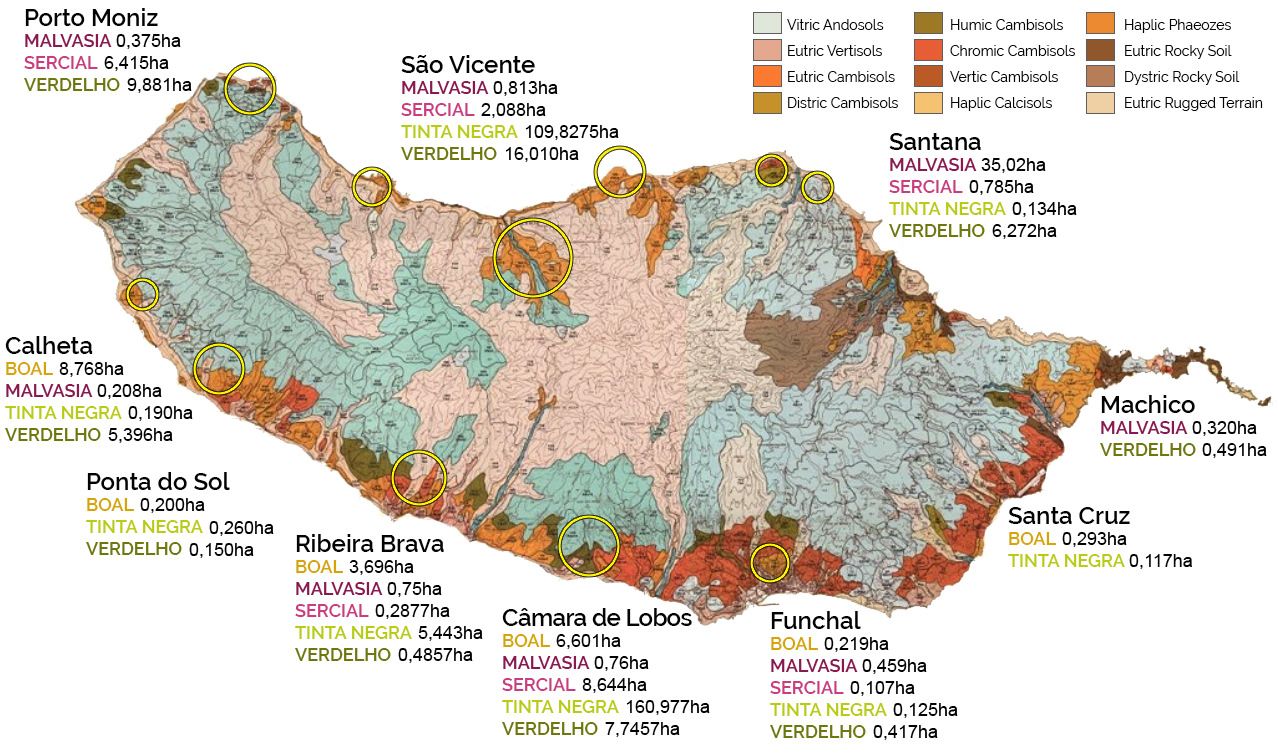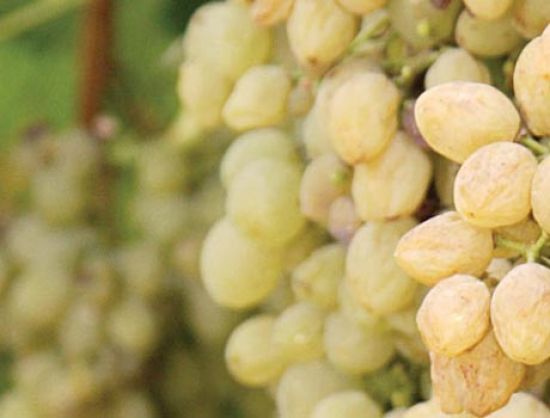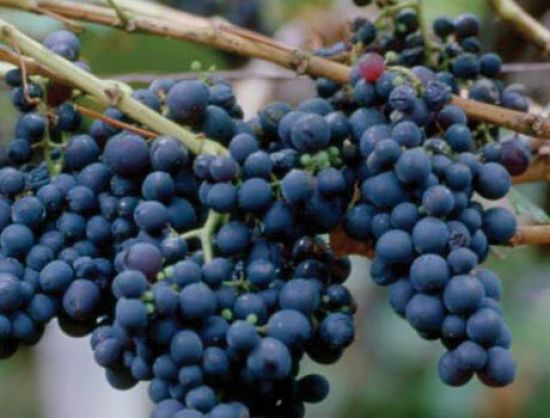Madeira Island Terroirs
The Island Terroirs
The island of Madeira, of volcanic origin, was discovered in 1419 by the Portuguese Captain, João Gonçalves Zarco, and is an archipelago composed of two inhabited islands – Madeira and Porto Santo – and two small uninhabited islets, the Desertas and the Selvagens.
Madeira’s location in the Atlantic made it an important strategic port of call which led to the rapid expansion of the island’s wine, especially in countries such as the United States of America. It was so popular in the USA that in the 18th century, Madeira wine is reported to have represented over 75% of all wine imported into this market.
The archipelago is situated at 32º 38’ latitude north and 16º 54’ longitude west, about 1100kms off the coast of Portugal, and 590 kms off the coast of Morocco. The total area of the island is 741 kms2, of which the vineyards occupy about 490 hectares.
The island relief is steep and a mountain range that climbs up to 1.862m (6.109Ft) in altitude above sea-level – the highest peak is Pico Ruivo – runs the length of the island, virtually dividing it in tow, and causing 7 different micro-climates that have a determining effect on where the vineyards are planted.
The overall sub-tropical and temperate climate, together with the fertile volcanic soils provide perfect conditions for the growth of a wide range of different crops.
The archipelago is situated at 32º 38’ latitude north and 16º 54’ longitude west, about 1100kms off the coast of Portugal, and 590 kms off the coast of Morocco. The total area of the island is 741 kms2, of which the vineyards occupy about 490 hectares.
The island relief is steep and a mountain range that climbs up to 1.862m (6.109Ft) in altitude above sea-level – the highest peak is Pico Ruivo – runs the length of the island, virtually dividing it in tow, and causing 7 different micro-climates that have a determining effect on where the vineyards are planted.
The overall sub-tropical and temperate climate, together with the fertile volcanic soils provide perfect conditions for the growth of a wide range of different crops.
Terroir(s)
Madeira is rich and diverse in terroirs. As a volcanic island in the middle of the Atlantic Ocean, the vineyards are exposed to the ocean breeze and the grapes from vineyards planted at lower levels can show saline and iodine notes.
The soils are acidic, rich in mineral, iron and phosphor, and poor in potassium, which all contribute to the trademark acidity of the wine. In fact, the acidity is one of the most remarkable assets of the wines, allowing this unique wine to keep fresh even after having been bottled for many years.
Irrigation is provided by an ancient system of canals called “levadas” that brings water from the mountains down to the agricultural plots, until the ocean
The soils are acidic, rich in mineral, iron and phosphor, and poor in potassium, which all contribute to the trademark acidity of the wine. In fact, the acidity is one of the most remarkable assets of the wines, allowing this unique wine to keep fresh even after having been bottled for many years.
Irrigation is provided by an ancient system of canals called “levadas” that brings water from the mountains down to the agricultural plots, until the ocean
PDO Madeira
(Protected Designation of Origin) Main grape varieties distribution map

Grape Varieties

Sercial
This is a white grape variety that probably originates from the region of Bucelas, near Lisboa, where it is traditionally grown under the name Esgana Cão (Dog Strangler), having been introduced in Madeira, where it was given the name Sercial.
The vineyards are located both on the north and south side of the island. At south, we find it at high elevations in Jardim da Serra, above Estreito de Câmara de Lobos, between 600m to 800m high, and at north, in the areas of Porto Moniz, São Vicente and Seixal, at lower altitudes, between 150 – 200m.
Sercial bunches are medium sized, thin skinned and the berries are prone to rot. It has a very late ripening and is resistant to oidium and mildium, being normally the last grape variety to be harvested. This slow maturation, the result of the terroir where it is grown, produces wines that rarely achieve more than 11% alcohol before fortification.
In Madeira Wine, due to its natural mouthwatering, tangy, crisp and racy acidity, balanced by its slight sweetness, Sercial is always used to produce dry wines, which are light bodied and exceptionally fresh, and present intense and vibrant aromas. Sercial begins its life pale in color, but over the course of time it deepens and darkens to amber.
It is not only an extraordinary aperitif or after-dinner wine (Colheita and Vintage) as it is the only Madeira Wine that can as well, if young, be enjoyed along a meal.
The vineyards are located both on the north and south side of the island. At south, we find it at high elevations in Jardim da Serra, above Estreito de Câmara de Lobos, between 600m to 800m high, and at north, in the areas of Porto Moniz, São Vicente and Seixal, at lower altitudes, between 150 – 200m.
Sercial bunches are medium sized, thin skinned and the berries are prone to rot. It has a very late ripening and is resistant to oidium and mildium, being normally the last grape variety to be harvested. This slow maturation, the result of the terroir where it is grown, produces wines that rarely achieve more than 11% alcohol before fortification.
In Madeira Wine, due to its natural mouthwatering, tangy, crisp and racy acidity, balanced by its slight sweetness, Sercial is always used to produce dry wines, which are light bodied and exceptionally fresh, and present intense and vibrant aromas. Sercial begins its life pale in color, but over the course of time it deepens and darkens to amber.
It is not only an extraordinary aperitif or after-dinner wine (Colheita and Vintage) as it is the only Madeira Wine that can as well, if young, be enjoyed along a meal.

Verdelho
Verdelho can be found since the seventeenth century and was probably brought from northern continental Portugal during the early days of settlement on the island. Before the arrival of phylloxera in Madeiram, in 1872, Verdelho represented approximately two thirds of the vineyards of Madeira.
Today is the white variety with the largest area (47 hectares) in Madeira, especially on the north coast, in vineyards located in Ponta Delgada, and São Vicente, planted at altitudes up to 100m high. On the south coast, this varietal is located at altitudes above 400 metres in Prazeres and Câmara de Lobos.
This variety requires deep soils with some degree of moisture. It has low yields per ha and early ripening. Grapes are normally picked by the end of September, and produce gold coloured medium dry elegant wines which have a tropical and exotic character.
The varietal offers compact and small bunches with a few berries. The must has moderate sugar levels and a marked acidity. In Madeira Wine, Verdelho is always vinified to produce medium-dry fortified wines.
Today is the white variety with the largest area (47 hectares) in Madeira, especially on the north coast, in vineyards located in Ponta Delgada, and São Vicente, planted at altitudes up to 100m high. On the south coast, this varietal is located at altitudes above 400 metres in Prazeres and Câmara de Lobos.
This variety requires deep soils with some degree of moisture. It has low yields per ha and early ripening. Grapes are normally picked by the end of September, and produce gold coloured medium dry elegant wines which have a tropical and exotic character.
The varietal offers compact and small bunches with a few berries. The must has moderate sugar levels and a marked acidity. In Madeira Wine, Verdelho is always vinified to produce medium-dry fortified wines.

Terrantez
As most of the varietals on the island, Terrantez was brought from the north of mainland Portugal, where it goes by the name of Folgasão. For many centuries this varietal has always been used in the production of premium wines, achieving high prices in the market.
Rare, Terrantez grapes are white, thin-skinned and extremely fragile. The compact bunches and berries make it prone to botrytis and berry splitting. The yields are very low and ripening late.
Due to its fragile nature, it has been replaced by more prolific varieties, and was therefore almost brought to extinction. Lately, the family has persuaded growers to bring back production levels. Any Terrantez Madeira is rare enough to be worth trying.
Rare, Terrantez grapes are white, thin-skinned and extremely fragile. The compact bunches and berries make it prone to botrytis and berry splitting. The yields are very low and ripening late.
Due to its fragile nature, it has been replaced by more prolific varieties, and was therefore almost brought to extinction. Lately, the family has persuaded growers to bring back production levels. Any Terrantez Madeira is rare enough to be worth trying.

Bual
Bual, or Boal as it is also called in Madeira, is a white grape variety that originated on the Portuguese mainland (or continente as it is known in Madeira) having been planted in the Douro and Dão for centuries, where it goes by the name of Malvasia Fina. This varietal name covers not one but 16 grape varieties in Portugal, as Cincinnato da Costa writes in “O Portugal Viticola”. In Wine Grapes (Robinson et al.) viticulturalist Rolando Faustino suggests that it is probably from the Douro but due to its wide genetic diversity neither Dão nor the Lisbon region can be ruled out.
In Madeira, Bual, with a total registered vineyard area of no more than 20 hectares is grown mainly in the southern coast of the island, where it is sunnier and warmer, as it does not perform well on the cooler and damper north side.
The best wines come from small plots (poios) in Campanário, Calheta, Arco de Calheta and Ponta do Pargo, to the west of Funchal, located at altitudes ranging between 100m and 300m above sea-level.
This varietal is quite vigorous and relatively easy to grow, only moderately susceptible to powdery mildew (Oidium) and botrytis bunch rot, and has a late budding, allowing it not be so exposed to the risk of spring frosts. Its bunches are large, and ripen early.
In Madeira Wine, thanks to its good acidity that balances the sweetness, Bual produces medium bodied, light copper-coloured medium sweet wines that are intensively perfumed, rich in spice and dried fruit, and achieve admirable longevity.
In Madeira, Bual, with a total registered vineyard area of no more than 20 hectares is grown mainly in the southern coast of the island, where it is sunnier and warmer, as it does not perform well on the cooler and damper north side.
The best wines come from small plots (poios) in Campanário, Calheta, Arco de Calheta and Ponta do Pargo, to the west of Funchal, located at altitudes ranging between 100m and 300m above sea-level.
This varietal is quite vigorous and relatively easy to grow, only moderately susceptible to powdery mildew (Oidium) and botrytis bunch rot, and has a late budding, allowing it not be so exposed to the risk of spring frosts. Its bunches are large, and ripen early.
In Madeira Wine, thanks to its good acidity that balances the sweetness, Bual produces medium bodied, light copper-coloured medium sweet wines that are intensively perfumed, rich in spice and dried fruit, and achieve admirable longevity.

Malvasia (Malmsey)
Malmsey should not be viewed as a single variety (there are so many different grapes named Malvasia) but as style of wine. In “Wine Grapes” (Robinson et al.) the authors make this point, stating that Malvasia is a generic name given to a wide range of distinct white-, pink-, grey-, or black-skinned varieties which share an ability to produce sweet wines high in alcohol. The planted area is now stable at around 39 ha (96 acres).
The majority of the Malvasia growing on Madeira is a grape known as Malvasia Branca de São Jorge, a white grape variety introduced as recently as the 1970s in the parish of Sao Jorge in the district of Santana, on the north side of the island at lower altitudes (150m – 200m). The bunches are large and conic, and usually show early budding and late ripening. It is the first to be harvested, having an early maturation. The grapes are sweet and produce rich full-bodied wines that are dark in colour. On the mouth, the bouquet reveals notes of spices and honey. It bears no relation to the prized Malvasia Candida, introduced to Madeira in the 15th century, of which there are now only 3 hectares growing on Madeira, exclusively on the south coast.
A young Malmsey Madeira is light golden in colour, whereas old Malmseys dark amber tonalities. Rich, smooth and luscious on the palate, showing complex notes of moka, dried fruit and honey, hints of tropical fruit, butterscotch, toffee-nuts and marmalade.
The majority of the Malvasia growing on Madeira is a grape known as Malvasia Branca de São Jorge, a white grape variety introduced as recently as the 1970s in the parish of Sao Jorge in the district of Santana, on the north side of the island at lower altitudes (150m – 200m). The bunches are large and conic, and usually show early budding and late ripening. It is the first to be harvested, having an early maturation. The grapes are sweet and produce rich full-bodied wines that are dark in colour. On the mouth, the bouquet reveals notes of spices and honey. It bears no relation to the prized Malvasia Candida, introduced to Madeira in the 15th century, of which there are now only 3 hectares growing on Madeira, exclusively on the south coast.
A young Malmsey Madeira is light golden in colour, whereas old Malmseys dark amber tonalities. Rich, smooth and luscious on the palate, showing complex notes of moka, dried fruit and honey, hints of tropical fruit, butterscotch, toffee-nuts and marmalade.

Tinta Negra
The only red grape variety used in Madeira Wine. Introduced after the phylloxera plague, this varietal has a thicker skin compared to the white varietals, higher yields, and more vigor. Versatile and productive, it accounts for approximately 80% of the island production, being used predominately to make 3 year old wines, although not exclusively.
Depending on the altitude, humidity, region and solar exposure, the grapes can deliver richer or drier wines. This varietal is diverse enough to be able to represent any one of the 4 styles of Madeira.
The family currently has large stocks of Tinta Negra ageing in oak barrels.
Depending on the altitude, humidity, region and solar exposure, the grapes can deliver richer or drier wines. This varietal is diverse enough to be able to represent any one of the 4 styles of Madeira.
The family currently has large stocks of Tinta Negra ageing in oak barrels.
Contact Information
Plataforma 3, Pavilhão T, ZFI da Madeira
9200-047 Caniçal, Madeira, Portugal.
Phone
(+351) 291 740 100
cossartgordon@madeirawinecompany.com
© Cossart Gordon




